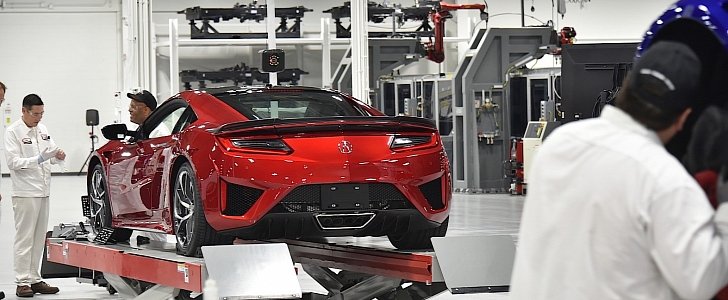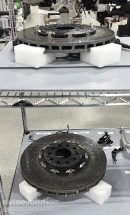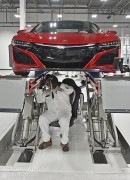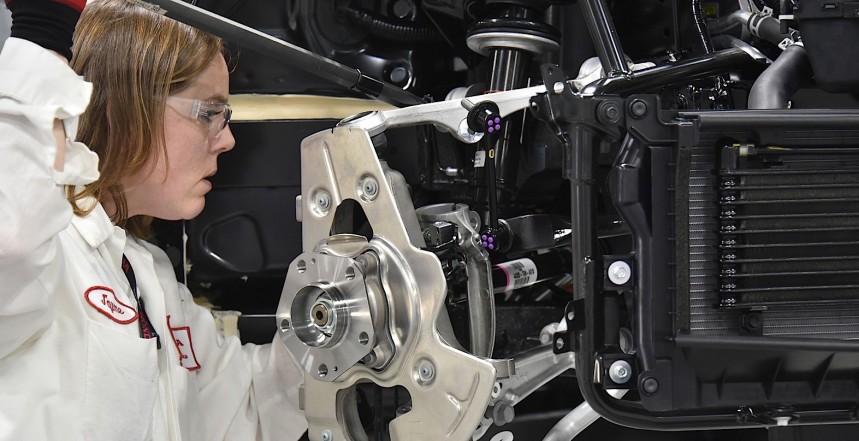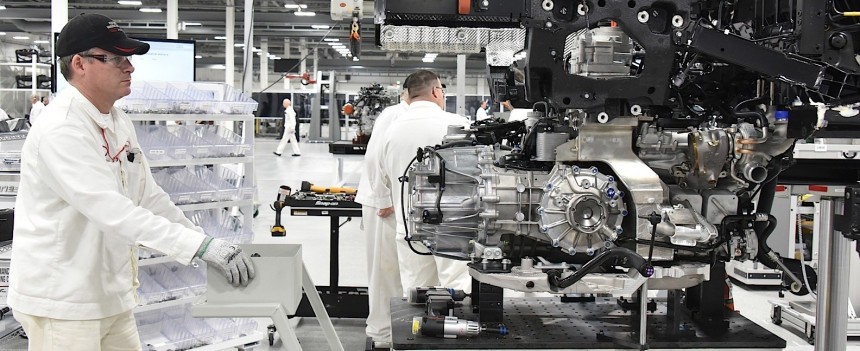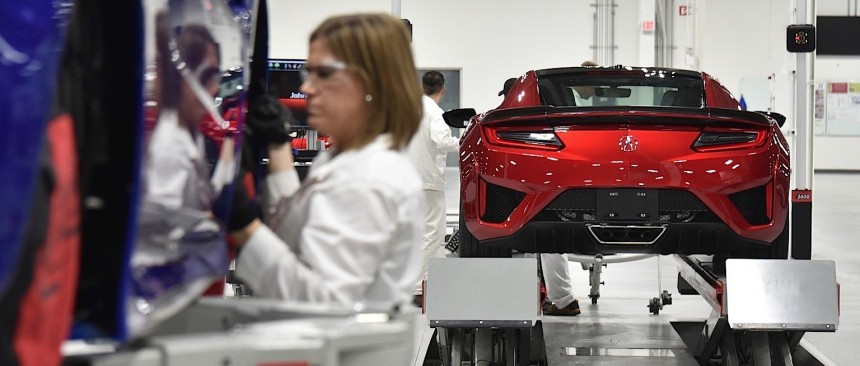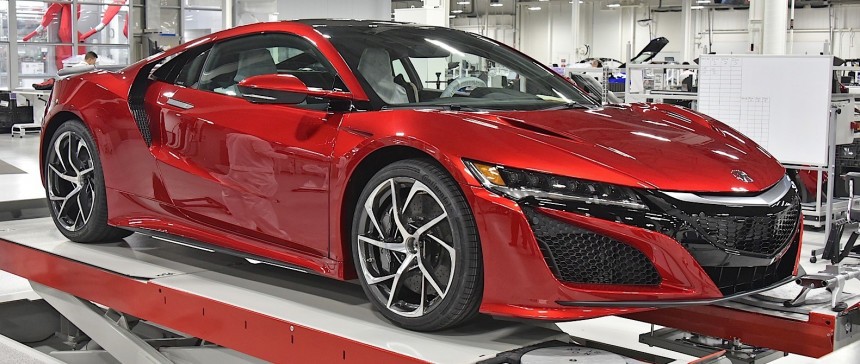A long hello is quite different from the long goodbye. In the case of the 2016 Acura NSX, this hello has taken a bit longer than usual.
Prototypes of the second-generation NSX have been with us for several years now, through various fits and starts, laps on the ‘ring, tech center visits and back, until company engineers have deemed the recipe “just right.” On the eve of the production start of version 2.0, Acura took us to Marysville, Ohio, for a peek behind the curtain, where all this supercar’s magic really takes place.
With the NSX classified as a hand-assembled, machine-built vehicle, there are approximately 100 pairs of leather-gloved human hands that will touch it. A combination of best practices, it is a factory that features floor surfaces clean enough to eat from, innovative manufacturing techniques and rotisserie MIG welding jigs that flip the spaceframes over, upside down and sideways for the most efficient welds possible.
Creating quality is at the core of Acura’s strategy for the NSX. As such, the PMC factory, which in an earlier life was a warehouse, is structured from inside out, starting with its glass core, which is also the quality confirmation center, easily accessible from all departments. More on that later. The factory is populated by welding stations, paint booths, and assembly bays, and set up for stops at the centrally located Quality Confirmation Center (QCC) along the way.
Acura has gone off the deep end, totally submersing themselves in newer tech for a world-class supercar. In the welding department for instance, a rotisserie system allows robots 360-degree access. Aluminum space frames are inherently susceptible to heat distortion. The rotisserie alleviates that problem, and results in the MIG welding robots performing very high integrity welds, which are very strong with very high repeatability.
The NSX features a number of innovative build procedures including Ablation Casting for parts on the aluminum space frame. Used to join the upper and lower front and rear nodes, they are critical mounting points for the various pieces of hardware. The sand-casted parts are also part of the crumple zones when building the NSX space frame.
Once completed, the spaceframe goes to another rotisserie where it is extensively sealed against elements and dust that could penetrate the interior while at speed.
The Honda Anna engine plant is about an hour west of Marysville. There, they make around 1.1-million engines per year (4,800 per day), give or take a hundred thousand or so. The 3.5-liter twin turbo V6 is built in a special skunkworks section of the Anna plant, where master builders assemble the engine, dyno it, and then attach the transmission and send it to the PMC. The engine build facility features a small and quiet room in the center of the plant and utilizes one builder per engine. These Acura master builders have about 24 years of experience each, building engines at Honda. Through extensive training in the US and Japan, they have learned how to not only build the engine but the “Why?” behind the engine.
Within the specialty engine room, sub-assembly areas build cam and crankshafts, piston and rod setups and variable valve timing kits. Each engine is started from what Acura calls a “Kit Cart,” which holds every part used to build a running powerplant. An average build takes five to six hours and is confirmed by Visual Operations Screens above each workstation that shows what goes where. If there are parts left over, somebody didn’t do their job properly.
After the completed build, and a three-hour curing period for liquid-style sealing to settle, the 3.5-liter Twin Turbo V6 is prepped for a simulated 150-mile break-in period so the car is ultimately broken in for the customer from the first push of the ignition button. The water-cooled electric rear motor is mounted to the rear of the V6. The entire unit is custom balanced by using weighted bolts to eliminate vibration. The 9-speed dual clutch transmission (DCT) is built in Honda’s Hamamatsu transmission plant in Japan, using the same practices and protocols as those found in the PMC.
The NSX has a total of 547 bolts, and all of them are hand-started. Once properly seated, they are torqued down using a wirelessly connected torque wrench. Sending data up to Acura’s “cloud” records every turn of the wrench for later reference, the end-result being a birth history for every single engine built in the Anna plant.
The engine sets, and many other component parts, are shipped to the PMC for final assembly.
The paint shop is another example of innovation that seems designed and engineered in fantasyland, with the latest in spray guns and glass booths so a customer can watch their car being prepped and sprayed without the fear of getting painted themselves. Spaceframes go through one section, while body panels make it through another.
Completed spaceframes are checked at the QCC to meet standards with a Romer device that checks tolerances of welds and attachments. Once confirmed, the car is rolled on a dolly into the assembly line where expert builders start to create what NSX Project Manager Clement D’Souza describes as a “low-flying jet.” Carbon-fiber floor panels, engine firewalls, hybrid batteries and other components appear and are installed by teams of leather-gloved builders in a factory which turns out to be surprisingly quiet.
The interiors are built up according to the market each car will be delivered to. Left and right-hand-drive vehicles are interspersed and the technicians easily adapt, regardless of the orientation. The powerplant and transmission assemblies are lifted and married to the frame and then front and rear suspensions and drivetrains appear on the scene for their call, all started by a technician’s hand before being torqued home.
The exterior panels are installed at the very end and aligned to the most precise tolerances. Essentially, the car is built from the inside out, similar to the way a bathroom is tiled, so that everything lines up properly with little need for adjustment later.
Each master engine builder in Anna, and every constructor at the PMC essentially “owns the build” within their station. As such, if the work just completed does not meet personal standards, not to mention company protocols, builders are empowered to call it out to redo or pull it out of production for a correction. Acura officials claim this is the best way to insure top-notch quality for the NSX.
Final inspection follows. It is here where engineers and Acura associates take measurements of gaps, body panels, weld densities and other parameters to guarantee one NSX is as potent as the next. At that point, the car goes through final inspection checking acceleration, braking, and weather sealing before being sent on its way to customers around the globe.
Having already built 150 samples for testing and crash certification, as well as media drives, Acura is almost ready to hang a shingle. Output at the PMC is expected to be 8-10 units per day. Once they ramp up to that level, orders will start to be filled. Domestically, the company expects to sell 800 cars per year, the most of any region. The NSX will be sold in North America and most of the world as an Acura, while Honda badging will appear in a few markets including Japan.
Just as each NSX is unique, every process is unique to the NSX.
Paying attention to the men and women behind the curtain
Not too far from Columbus, Ohio, sits the burgh of Marysville, which is home to more than a few cornfields, cattle ranches, and the Honda Marysville Auto Plant (MAP). Honda R&D, the Honda Heritage Center, and a few support concerns are also nearby. The newest facility is the Performance Manufacturing Center (PMC). As it lies now, it does not sport a brand name, despite it being the birthplace of the new Acura NSX. We do suspect there will be many future offerings to come from the PMC’s roller doors, branded as both Acura and Honda, but today is all about the new Acura NSX.With the NSX classified as a hand-assembled, machine-built vehicle, there are approximately 100 pairs of leather-gloved human hands that will touch it. A combination of best practices, it is a factory that features floor surfaces clean enough to eat from, innovative manufacturing techniques and rotisserie MIG welding jigs that flip the spaceframes over, upside down and sideways for the most efficient welds possible.
Creating quality is at the core of Acura’s strategy for the NSX. As such, the PMC factory, which in an earlier life was a warehouse, is structured from inside out, starting with its glass core, which is also the quality confirmation center, easily accessible from all departments. More on that later. The factory is populated by welding stations, paint booths, and assembly bays, and set up for stops at the centrally located Quality Confirmation Center (QCC) along the way.
A new level of man and machine synergy
The NSX features a number of innovative build procedures including Ablation Casting for parts on the aluminum space frame. Used to join the upper and lower front and rear nodes, they are critical mounting points for the various pieces of hardware. The sand-casted parts are also part of the crumple zones when building the NSX space frame.
Once completed, the spaceframe goes to another rotisserie where it is extensively sealed against elements and dust that could penetrate the interior while at speed.
Off-site buildups
Within the specialty engine room, sub-assembly areas build cam and crankshafts, piston and rod setups and variable valve timing kits. Each engine is started from what Acura calls a “Kit Cart,” which holds every part used to build a running powerplant. An average build takes five to six hours and is confirmed by Visual Operations Screens above each workstation that shows what goes where. If there are parts left over, somebody didn’t do their job properly.
After the completed build, and a three-hour curing period for liquid-style sealing to settle, the 3.5-liter Twin Turbo V6 is prepped for a simulated 150-mile break-in period so the car is ultimately broken in for the customer from the first push of the ignition button. The water-cooled electric rear motor is mounted to the rear of the V6. The entire unit is custom balanced by using weighted bolts to eliminate vibration. The 9-speed dual clutch transmission (DCT) is built in Honda’s Hamamatsu transmission plant in Japan, using the same practices and protocols as those found in the PMC.
The NSX has a total of 547 bolts, and all of them are hand-started. Once properly seated, they are torqued down using a wirelessly connected torque wrench. Sending data up to Acura’s “cloud” records every turn of the wrench for later reference, the end-result being a birth history for every single engine built in the Anna plant.
The engine sets, and many other component parts, are shipped to the PMC for final assembly.
A touch of color, then get busy
Completed spaceframes are checked at the QCC to meet standards with a Romer device that checks tolerances of welds and attachments. Once confirmed, the car is rolled on a dolly into the assembly line where expert builders start to create what NSX Project Manager Clement D’Souza describes as a “low-flying jet.” Carbon-fiber floor panels, engine firewalls, hybrid batteries and other components appear and are installed by teams of leather-gloved builders in a factory which turns out to be surprisingly quiet.
The interiors are built up according to the market each car will be delivered to. Left and right-hand-drive vehicles are interspersed and the technicians easily adapt, regardless of the orientation. The powerplant and transmission assemblies are lifted and married to the frame and then front and rear suspensions and drivetrains appear on the scene for their call, all started by a technician’s hand before being torqued home.
The exterior panels are installed at the very end and aligned to the most precise tolerances. Essentially, the car is built from the inside out, similar to the way a bathroom is tiled, so that everything lines up properly with little need for adjustment later.
Calling it out
Final inspection follows. It is here where engineers and Acura associates take measurements of gaps, body panels, weld densities and other parameters to guarantee one NSX is as potent as the next. At that point, the car goes through final inspection checking acceleration, braking, and weather sealing before being sent on its way to customers around the globe.
Having already built 150 samples for testing and crash certification, as well as media drives, Acura is almost ready to hang a shingle. Output at the PMC is expected to be 8-10 units per day. Once they ramp up to that level, orders will start to be filled. Domestically, the company expects to sell 800 cars per year, the most of any region. The NSX will be sold in North America and most of the world as an Acura, while Honda badging will appear in a few markets including Japan.
Just as each NSX is unique, every process is unique to the NSX.
